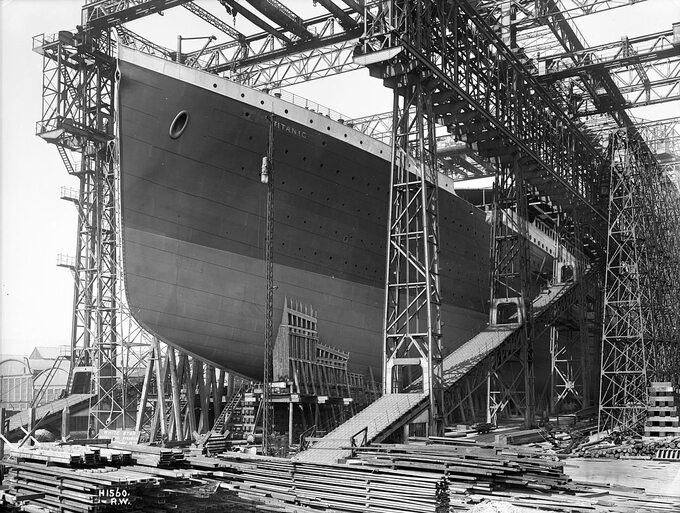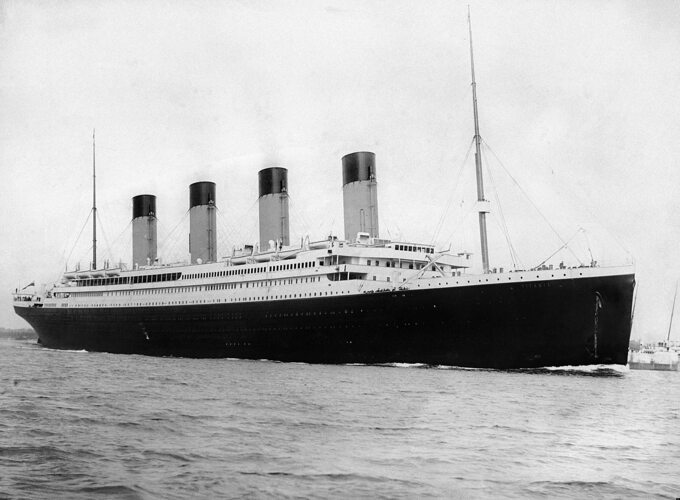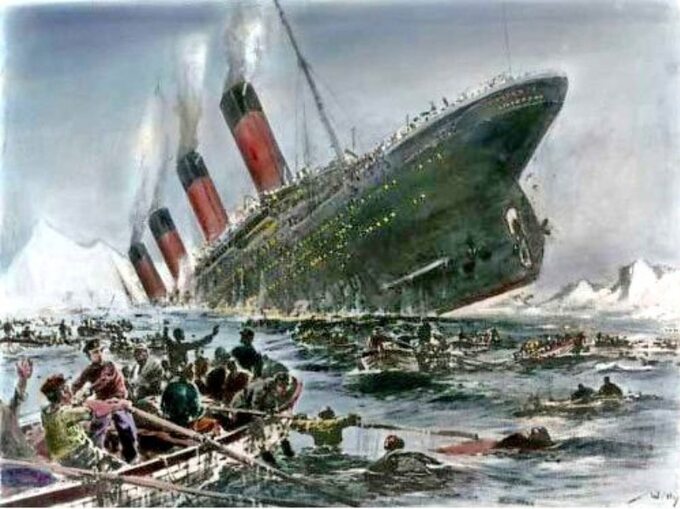The tragic journey of the Titanic, which, according to its designers, should have “sunk”, still arouses interest. Much of this is due to pop culture, particularly the Oscar-winning film Titanic, directed by James Cameron. What did the first and last voyage of the then world's largest passenger ship look like? What did they eat on this luxurious ship?
construction
Titanic was built over 2 years – from March 30, 1909 to May 31, 1911, by almost 4,000 workers at the Harland and Wolff shipyard in Belfast. The goal was to create the largest mobile facility in the world. In addition to Titanic, two more twin ocean liners were built at that time: Britannic and Olympic. Naval architects Alexander Carlyle and Thomas Andrews were responsible for their design.
The colossi were to be the fastest, best and largest ships in the history of navigation and at the same time extremely luxurious. When the Titanic sailed majestically in 1911, the world press rightly hailed it as the world's largest and grandest passenger ship and, this time deservedly, gave it a reputation as unsinkable and completely safe. – Dr. Janusz Osika said about the Titanic in the Two Millennium Chronicle program. – “It must have been the greatest jewel of the British passenger fleet.”

The dimensions were really impressive. The commissioned colossus was 269 m long, 29.41 m wide, 53.33 m high and 10.54 m draft, with a registered displacement of 46,329 tons. In addition, with the help of two engines and three propellers, it could reach a speed of 21 to 24 knots.
Titanic made her maiden voyage to New York from Southampton on April 10, 1912. The crew was commanded by the experienced Captain Edward Smith. This should have been a farewell cruise for him, a kind of “crowning” of his career. The route chosen for the Titanic was the risk of collision with icebergs. However, it was believed that such a modern ship could easily meet such threats.
More than 1,300 passengers and almost 900 crew members were on board at the time of the disaster. Passengers could purchase tickets for one of three classes. The most expensive tickets, with deluxe seats, cost an astonishing £870 at the time. However, there was no shortage of volunteers – there were aristocrats, artists and athletes on the Titanic. There were many attractions on the ship: you could read, talk and correspond in several halls. On the promenade terrace, where the sunbeds were placed, you can enjoy exquisite dishes and exquisite drinks. At the rear, on the other hand, was an elegantly appointed smoking room with mahogany paneling, stained glass windows and the only fireplace on board with a real fire. This was one of the most famous rooms on the Titanic. There were also cafes and restaurants where you could choose à la carte dishes. Sports lovers can enjoy the gym, swimming pool and squash court. And all this to the tune of melodies performed by the orchestra. Second-class passengers are accommodated in two- to four-person cabins with their own washroom, bed and luggage compartment. In addition, they had the opportunity to use a common smoking room, a living room and a library. III-class ticket buyers had to take seats in the collective cabin on the lower deck. They shared a common dining room, several bathrooms, and their own smoking room.
Menu from Titanic. It's impressive
With its reputation as a luxury ship, the Titanic served numerous cafes, restaurants and salons that, and it is not an exaggeration, would compete with the best restaurants in the capitals of Europe. Dozens of people worked in the Titanic's kitchen, preparing about 6,000 meals a day. On board there was a bakery and huge cold rooms where meat and vegetables were stored. Porcelain and silverware were stored in special rooms. There were thousands of liters of wine and beer in “cellars”. The kitchen has 19 ovens and even more burners for cooking and roasting.
The first class dinner consisted of about 13 courses and lasted about five hours. Each dish was served with a different wine. Popular delicacies included foie gras pate and Waldorf salad. In the second class, less varied dishes were served, although they were no less elaborate. Third class passengers couldn't complain either, although of course their meals were far from “first class” refinement. In third grade, they ate goulash, vegetable soup, roast pork, currant rolls, and plum pudding. Many third-class passengers, who often couldn't afford fresh fruit and vegetables, reportedly raved about the food they were served on the Titanic.

On the evening of April 14, 1912, what turned out to be the last supper was served on board. In first class, the meal began with raw oysters and cold appetizers. Then we were served Consommé Olga (veal broth) and creamy barley soup. After that, the waiters brought out salmon cooked in a thick sauce. Passengers could choose the following meals from among the many available. Among them were, for example, fish fillet, fried chicken, lamb in mint sauce, baked duck with apple sauce and beef with potatoes. Recommended additions were carrot cream, boiled rice, green peas, new potatoes and parmentier (potato casserole).
After this hearty “entrance” a “palate cleansing” drink made of wine, rum and champagne was served. Then baked pumpkin with watercress, asparagus and pies appeared on the tables. For dessert, guests were offered peaches covered in Chartreuse liqueur jelly, chocolate and vanilla eclairs, Waldorf salad, ice cream, fruits and nuts. At the end, coffee, port and cigars were served, and the passengers moved quite freely from the restaurant to the smoking room and the hall, where a band played the most popular songs of the day. The fun mood, like every evening, lasted until almost midnight.
disaster
At 11:40 p.m., the Titanic struck an iceberg, which blew a 300-foot (90 m) hole in its hull. According to some reports, the captain kept this information secret, perhaps not wanting to cause panic. Other sources say that the evacuation was led by a captain from then on, but he did so in a chaotic manner.
Radio operators began calling for help from other units. The closest ship to answer the call was the Carpathia, which was 58 nautical miles from the Titanic. She could have covered this distance in four hours, but it was still too late for the Titanic. Finally, the unit reached the disaster site when the Titanic was already at the bottom.

However, before the transatlantic sinking, Captain Smith ordered the firing of white rockets (red rockets are used as a warning in shipping) – the Californian, which was passing closest to the disaster site, did not react, as its crew probably thought. It was one of the attractions of the Titanic passengers. The crew of this ship has long been accused of failing to provide assistance – however, modern analysis of investigative reports suggests that the ship would have reached the disaster site safely before or at the same time as the Carpathian. The reason was icebergs, which made the cruise difficult.
The most common criticism of the creators of the Titanic is that there were too few lifeboats on the ship. This is one of the reasons why only 32 percent of the passengers were saved. Of the 2208 people who swam in the icy ocean, only 708 people survived. Another reason was the chaos in the evacuation operation – especially in its first phase, only a small number of lifeboats remained. Only after some time did the whole boats start to be “filled” with people. There were almost no attempts to save people in the water. Only the fifth mate, Harold Lowe, divided the passengers from his boat among the other boats and went to pull the swimmers out to sea, but he still managed to save only a few people.
The disaster caused a great social resonance. “If you can't provide more lifeboats, sell fewer tickets.” Don't drown the people in the most beautiful night to ever happen in the Atlantic. Even if they had to sink with the music you provide, – wrote Joseph Conrad, impressed by the disaster, to the shipowners. The tragedy that befell the passengers of the Titanic was an extremely bitter pill for everyone. A “brilliant” technical idea turned out to be nothing compared to nature.
Also read:
Modern Pompeii. What effect did the eruption of the Indonesian volcano have on the fate of the world?Also read:
They almost wiped out Homo sapiens. Supervolcanoes still threaten humanity
(Tags translated)Titanic
